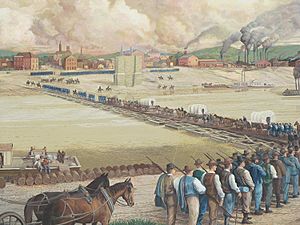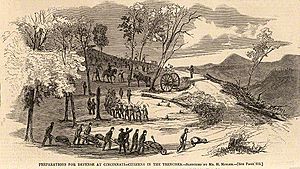Defense of Cincinnati facts for kids
Quick facts for kids Defense of Cincinnati |
|||||||
|---|---|---|---|---|---|---|---|
| Part of the American Civil War | |||||||
 A modern mural depicting the "Squirrel Hunters" crossing the Ohio River for the defense of Cincinnati. |
|||||||
|
|||||||
| Belligerents | |||||||
| Commanders and leaders | |||||||
| Lew Wallace | Henry Heth | ||||||
| Strength | |||||||
| 85,000 [approximate 25,000 military & 60,000 militia] |
8,000 [approximate] |
||||||
| Casualties and losses | |||||||
| 6 total 1 killed 5 wounded |
unknown | ||||||
The Defense of Cincinnati happened during the American Civil War. From September 1 to September 13, 1862, the city of Cincinnati, Ohio was in danger. Confederate forces were moving north, threatening this important city. This event was part of a larger plan by the Confederates called the Confederate Heartland Offensive.
Contents
Protecting Cincinnati: A City Prepares
In 1862, Cincinnati was the sixth-largest city in the United States. Confederate Brigadier General Henry Heth was ordered to move toward Cincinnati. His goal was not to attack directly, but to scare the city and make it seem like an attack was coming.
Cincinnati's mayor, George Hatch, ordered all businesses to close. Union Major General Lew Wallace took charge of the city's defense. He declared martial law, which meant the military took control. Wallace quickly organized the people of Cincinnati and nearby towns like Covington and Newport, Kentucky to defend their homes.
The Black Brigade: Building Defenses
One special group that helped was the "Black Brigade of Cincinnati". This group was made up of free African Americans. They were forced to join the defense efforts. Even though they weren't given weapons, they received their own flag. They were paid $13 for a month's work, which was the same pay as a private soldier.
The Black Brigade played a huge role in building defenses. They worked hard to create miles of military roads. They also built breastworks (low walls for protection), forts, and rifle pits. These defenses were built in Kentucky, across the river from Cincinnati. They even cleared hundreds of acres of forest. The trees were sometimes used to create obstacles called abatis, which are like tangled barriers of sharpened branches.
Volunteers and Soldiers Unite
About 25,000 Union soldiers and 45,000 local volunteers defended these new fortifications. An extra 15,000 men, known as the "Squirrel Hunters," also came to help. These were untrained volunteers from other parts of Ohio. They often carried old equipment, but they were ready to protect their state.
The building of these defenses was first led by Colonel Charles Whittlesey. Later, Major James H. Simpson took over. On September 5, the governor of Ohio, David Tod, announced that no more volunteers were needed. However, he asked all military groups to stay ready for future needs.
Confederate Retreat: The Threat Ends
General Heth and his Confederate soldiers marched from Lexington, Kentucky. They arrived south of Covington on September 6. Heth looked at the strong defenses that Cincinnati had built. He quickly realized that attacking the city would be useless.
Heth's forces stayed only a few days. They had small fights with Union soldiers from the 101st Ohio Infantry, 103rd Ohio Infantry, and 104th Ohio Infantry near Fort Mitchel. This happened on September 10 and 11. By September 12, Heth's troops began to march back south to Lexington.
General Wallace quickly sent a message, saying, "The skedaddle is complete; every sign of a rout." He wanted to chase after Heth's army with 20,000 men. However, this large chase was never ordered. Most of the Union forces were sent to Louisville, Kentucky. They needed to protect Louisville from another Confederate general, Braxton Bragg.
Still, small groups of Union soldiers were sent to bother Heth's retreating forces. There was a small fight in Florence, Kentucky, on September 17. Another fight happened near Walton, Kentucky, on September 25. Here, Colonel Basil W. Duke attacked a Union camp.
Because of his strong defense of Cincinnati, General Wallace earned the nickname "Savior of Cincinnati." Within a month of the scare, the "Squirrel Hunters" went back to their homes.
Fortifications Built for Defense

The Black Brigade of Cincinnati played a key role in building these defenses. Seven hundred and six members of the brigade worked in Kentucky. They had no weapons and only a few cavalry scouts between them and the Confederate troops.
The brigade worked until September 20, when the threat to Cincinnati was completely gone. By then, they had cleared hundreds of acres of forests. They also dug miles of rifle pits. They built forts, magazines (places to store ammunition), and many miles of military roads and breastworks. These defenses stretched along the border with Northern Kentucky, from Fort Thomas to Bromley. The fortifications were built far enough away that Confederate cannons could not reach Cincinnati.
Key Defensive Positions
In September 1862, there was one earthwork fort and eight earthwork batteries ready to defend Cincinnati. These had been built in 1861. Two batteries protected the city's sides, located on hills to the west and east of Cincinnati. Overall, these defenses had only 15 heavy guns.
General Wallace moved his headquarters to Kentucky. He chose the main building at the Thompson Winery, which was called Fort Henry. This was the center of the defense line. Telegraph lines connected all the earthwork positions to his headquarters. After the threat passed, many more batteries and forts were built until November 1864. Major James H. Simpson mostly directed this work.
Important Kentucky Batteries
Many batteries were built in Kentucky to protect Cincinnati. Most of these earthworks are now gone.
- Fort Mitchel: This fort was built in 1861 and named after Major General Ormsby M. Mitchel. He first directed the building of Cincinnati's defenses. The city of Fort Mitchell, Kentucky is named after him and the fort.
- Fort Wright: Built in 1863, this fort was designed to hold many heavy guns. It could cover a large area from Kyle Battery to the Licking River. It was named for Major General Horatio Wright. The city of Fort Wright, Kentucky is named after this fort.
- Anderson Battery: This battery was first called Tunnel Battery because it was above a railroad tunnel. It was renamed for Larz Anderson, a Cincinnati businessman. You can still see small parts of this earthwork today.
- Holt Battery: This earthwork is easily accessible and is owned by Vista Pointe Apartments in Wilder, Kentucky.
- Shaler Battery: This battery was located on land owned by Dr. Nathaniel B. Shaler, near Evergreen Cemetery. Today, the cemetery covers the entire property. This is one of the easiest remaining defensive positions to visit.
Ohio Batteries
Defenses were also built on the Ohio side of the river.
- Price's Hill Battery: Located on the western edge of Cincinnati, overlooking the Ohio River.
- Mount Adams Battery: Found on the eastern side of Cincinnati, near Immaculata Church on Mount Adams. This area is now known as Fort View Place.
- Butcher's Hill Battery: Located near the current site of Cincinnati Playhouse in the Park in Eden Park.

